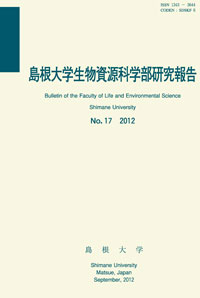島根大学生物資源科学部
ISSN:2435-0885(online)
ISSN:1343-3644(in print)
A publication of this bulletin in print format has not been made since no 24.
ISSN:1343-3644(in print)
A publication of this bulletin in print format has not been made since no 24.

number of downloads : ?
Use this link to cite this item : https://ir.lib.shimane-u.ac.jp/5963
Bulletin of the Faculty of Life and Environmental Science Shimane University 11
2006-09-30 発行
Mineral Nutrition of Grazing Goats in Luzon Island, Philippines
Fujihara, Tsutomu
A. B. Serra
S. D. Serra
E. A. Orden
File
Description
A 15 years study was conducted to evaluate the influence of plant species, soil characteristics and seasonal changes on the mineral status of forages grazed by goats in Luzon Island, Philippines. About 200 goats of both sex with average body weight 10-25Kg and age ranging between 1 to 5 of native and cross bred were used. Mineral content of common forage species, distribution of mineral in fibre fraction, ruminal solubilization of mineral elements, blood mineral content of grazing goats and influence of soluble glass mineral bolus(SGB)on blood plasma mineral status were measured. Results showed that different in plant species, soil characteristics and seasonal changes contribute highly to the variation in mineral content of forage grazed by goats. Majority of these mineral elements are found in the non-structural cell components and are therefore degradable as indicated by their relatively high effective ruminal solubility(ERS).
Most species had low phosphorus(P), copper(Cu)and selenium(Se)while some had magnesium(Mg)and Zinc(Zn)levels lower than the critical limit relative to the animals’ needs. Subsequently affecting the plasma and serum concentration of grazing goats. Multipurpose tree species such as L. leucocephala, G. sepium and S. sesban showed relatively better mineral profile than other improved forage species. Although judicious concentrate supplementation increased plasma Zn concentration, plasma Cu and blood Se were still below critical level. Grazing upgraded goats showed positive response towards soluble glass mineral bolus(SGB)administration. There was a marked increase in blood Se level of treated does and their offspring. Likewise, milk suckled by kids born to SGB supplemented does contain higher Se level, indicative of active intra-mammary transfer of Se. However, this did not result to significant improvement in the birth weight and growth rate of kids. Results suggests that aside from minimal concentrate supplementation and elevated mineral intake provided by intraruminal SGB administration, the extensive utilization of leguminous tree species could correct mineral imbalances due to their relatively higher mineral content and ruminal solubility.
Most species had low phosphorus(P), copper(Cu)and selenium(Se)while some had magnesium(Mg)and Zinc(Zn)levels lower than the critical limit relative to the animals’ needs. Subsequently affecting the plasma and serum concentration of grazing goats. Multipurpose tree species such as L. leucocephala, G. sepium and S. sesban showed relatively better mineral profile than other improved forage species. Although judicious concentrate supplementation increased plasma Zn concentration, plasma Cu and blood Se were still below critical level. Grazing upgraded goats showed positive response towards soluble glass mineral bolus(SGB)administration. There was a marked increase in blood Se level of treated does and their offspring. Likewise, milk suckled by kids born to SGB supplemented does contain higher Se level, indicative of active intra-mammary transfer of Se. However, this did not result to significant improvement in the birth weight and growth rate of kids. Results suggests that aside from minimal concentrate supplementation and elevated mineral intake provided by intraruminal SGB administration, the extensive utilization of leguminous tree species could correct mineral imbalances due to their relatively higher mineral content and ruminal solubility.
About This Article
Other Article
PP. 35 - 41
